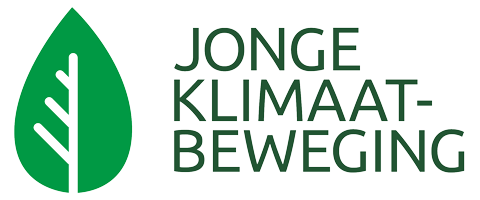De Jonge Klimaatagenda 3.0 is gelanceerd! Groter, completer en ambitieuzer dan ooit.
Hieronder vind je versie 2.0 van de Jonge Klimaatagenda uit 2019.
Jonge Klimaatagenda
Housing
Food
Education
Work
Transport
Housing
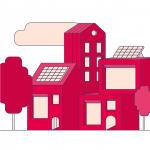 By 2050 we will make smart living choices by using the available space efficiently. We will own less space of our own, but we will share more space with others. We will reuse our home furnishings as much and as often as possible. Traditional transport networks will have made way for blue-green infrastructure, creating a pleasant living environment in and around heat-proof urban centres. By 2050 all existing housing will have been gradually made more sustainable, and energy consumption will be a major consideration when buying a new home. We will reuse or recycle all building materials and our flexible, carbon-emission-free homes will be built for reassembly. All the energy we use will be renewable.
By 2050 we will make smart living choices by using the available space efficiently. We will own less space of our own, but we will share more space with others. We will reuse our home furnishings as much and as often as possible. Traditional transport networks will have made way for blue-green infrastructure, creating a pleasant living environment in and around heat-proof urban centres. By 2050 all existing housing will have been gradually made more sustainable, and energy consumption will be a major consideration when buying a new home. We will reuse or recycle all building materials and our flexible, carbon-emission-free homes will be built for reassembly. All the energy we use will be renewable.
Food
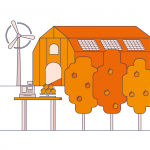 By 2050 we will have a sustainable, circular and transparent food chain. Food production using the best available technologies will have a positive impact on the planet and on nature. Socially responsible business conduct will be a given for food producers. Trade and retail will be the green link between consumers and producers. The range of foods available will reflect the aim to minimise environmental impact: our diet will be seasonal and we will pay the true cost of products. We will have a food culture that places a premium on the quality, sustainability, nutritional value and taste of our food. Our diet will consist mainly of plant-based products. We will not throw food away and will use only biodegradable packaging when necessary.
By 2050 we will have a sustainable, circular and transparent food chain. Food production using the best available technologies will have a positive impact on the planet and on nature. Socially responsible business conduct will be a given for food producers. Trade and retail will be the green link between consumers and producers. The range of foods available will reflect the aim to minimise environmental impact: our diet will be seasonal and we will pay the true cost of products. We will have a food culture that places a premium on the quality, sustainability, nutritional value and taste of our food. Our diet will consist mainly of plant-based products. We will not throw food away and will use only biodegradable packaging when necessary.
Education
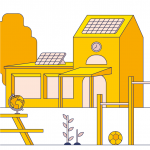 By 2050 sustainability will be a crosscutting theme in our education system. Children will learn relevant knowledge and skills in sustainable development from a young age, based on relevant issues and independently developed teaching material. Teaching in traditional classroom settings will be alternated with participatory learning, with a high degree of interdisciplinary collaboration. Young people will have a say in educational establishments’ sustainability policy. Educational facilities will serve as examples for the circular society. The school will be at the heart of the community which in turn will provide opportunities for learning. Retraining and further training in sustainable development will be accessible to everyone, different generations will learn from each other as a result of active collaboration and there will be a strong focus on training sustainability teachers.
By 2050 sustainability will be a crosscutting theme in our education system. Children will learn relevant knowledge and skills in sustainable development from a young age, based on relevant issues and independently developed teaching material. Teaching in traditional classroom settings will be alternated with participatory learning, with a high degree of interdisciplinary collaboration. Young people will have a say in educational establishments’ sustainability policy. Educational facilities will serve as examples for the circular society. The school will be at the heart of the community which in turn will provide opportunities for learning. Retraining and further training in sustainable development will be accessible to everyone, different generations will learn from each other as a result of active collaboration and there will be a strong focus on training sustainability teachers.
Work
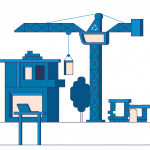 In 2050 we will be striving to achieve long-term wellbeing. Our economy will be circular and we will conduct business and investment activities in a sustainable and transparent manner. By involving stakeholders, organisations will have wide support for their sustainability policy. Employment levels in sustainable industries will be high. We will deploy our skills in meaningful work that contributes to a sustainable society. Everyone will engage in sustainable development, both at work and at home. We will pay the true cost of our impact on the environment and on people. We will use the increased leisure time available in ways that are sustainable, creative, social and healthy.
In 2050 we will be striving to achieve long-term wellbeing. Our economy will be circular and we will conduct business and investment activities in a sustainable and transparent manner. By involving stakeholders, organisations will have wide support for their sustainability policy. Employment levels in sustainable industries will be high. We will deploy our skills in meaningful work that contributes to a sustainable society. Everyone will engage in sustainable development, both at work and at home. We will pay the true cost of our impact on the environment and on people. We will use the increased leisure time available in ways that are sustainable, creative, social and healthy.
Transport
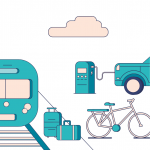 In 2050 we will opt for the most appropriate mode of emission-free transport for each journey we undertake. Journey planners will help us make these choices by providing us with information about the sustainability of travel recommendations. For everyday travel and outings, we will share vehicles and use rapid transit. Arranging virtual meetings will mean we can avoid unnecessary business trips. We will mostly remain within Europe for holidays and will travel by train. We will use as little energy as possible to transport our goods, and the energy we do use will be renewable, with most of the journey taking place by water and rail. Urban centres will be efficiently supplied by combining consignments and delivering them from distribution hubs.
In 2050 we will opt for the most appropriate mode of emission-free transport for each journey we undertake. Journey planners will help us make these choices by providing us with information about the sustainability of travel recommendations. For everyday travel and outings, we will share vehicles and use rapid transit. Arranging virtual meetings will mean we can avoid unnecessary business trips. We will mostly remain within Europe for holidays and will travel by train. We will use as little energy as possible to transport our goods, and the energy we do use will be renewable, with most of the journey taking place by water and rail. Urban centres will be efficiently supplied by combining consignments and delivering them from distribution hubs.
Housing 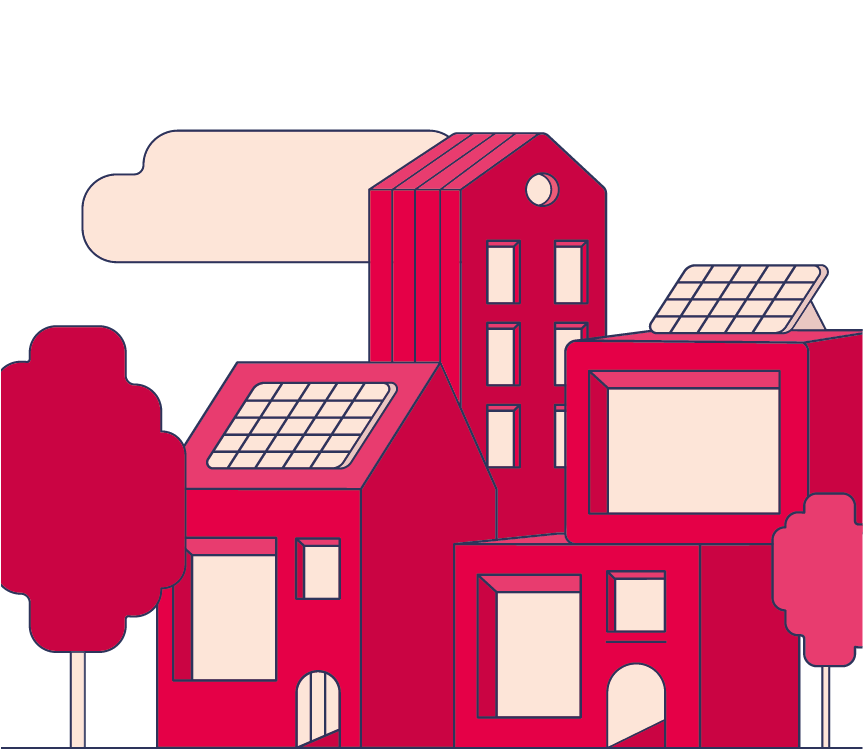
WHAT WILL OUR CITIES, TOWNS AND VILLAGES BE LIKE IN 2050?
By 2050 everyone will be living close to an attractive nature area. Heat-proof, healthy towns and cities will have more room for blue-green infrastructure. We will use the available space efficiently.
Blue-green infrastructure
By 2050 living in cities, towns and villages will be congenial for both people and animals. Blue-green infrastructure will ensure that the living environment is pleasant, sustainable and healthy for everyone. We will live no more than ten minutes’ walk from an attractive park with both greenery and water. Green areas with a lot of water will serve several functions, purifying the air, regulating temperature, providing a home for wildlife (including insects), relieving stress and reducing the risk of flooding.
Sustainable towns and cities
We will live in heat-proof towns and cities with good air quality. Rainwater will be partly collected, for use in homes for example, and will be slowly released back into the environment. There will be few car parks in the city and less traffic on the roads, so as to create space for blue-green infrastructure. Travel within urban areas will only be possible using environmentally-friendly means of transport. City centres will be completely car-free.
Smart use of space
By 2050 we will be making smart and efficient use of the available space, for instance by living in high-rise buildings, on water or in previously vacant properties. Our homes will be smaller, but we will have more space available to us because we will share space with others. Everyone will live in a home that suits their family, living and work situation. It will be easy to move into suitable housing and customary to swap homes, for instance for holidays.
HOW WILL WE BUILD OUR HOMES IN 2050?
By 2050 all existing housing will have been gradually made more sustainable and new homes will primarily be built to accommodate new lifestyles, using flexible construction systems. We will reuse or recycle all building materials, and energy consumption will be a major consideration when buying a new home.
Existing housing
By 2050 all housing built before 2050 will have been made more sustainable and will be energy neutral, including social housing and owner-occupied properties. Energy consumption will be greatly reduced and the energy still required will be generated sustainably. The process of making homes more sustainable will have proceeded at a gradual pace, with the occupants able to determine the timing and choose which measures to take.
New builds
By 2050 new housing will be completely carbon neutral in terms of both construction and use. We will use only green energy, and all building materials will be made and transported with no impact on the environment. New homes will be built using exclusively circular building materials and the building process will be automated wherever possible. We will make every effort to site new homes within existing built-up areas. High-rise buildings will be erected in urban areas. This will ensure a healthy balance between the natural and the built environment. Housing will be used flexibly across different target groups to optimise its lifespan. New homes will primarily be built to accommodate new lifestyles, such as multi-generational households or cohousing groups. The use of flexible construction systems will mean that homes can easily be made smaller or larger or adapted in line with changing housing requirements.
Use of materials
All raw materials will be reused or recycled, in both renovation and new-build projects. We will pay the true cost of high-quality materials, which will make reused materials cheaper than new products. Housing components will be designed to be dismantled easily. For example, it will be easy to remove windows, doors or floors from a residence without damaging them, so that they can be repaired, improved or reused in the same or another home. When building or renovating, the materials used will be entered into a materials database, giving builders and designers accurate information on what materials have been used where in a building and ensuring that they can easily be located and reused.
Buying a home
When purchasing a property, the buyer will always be informed about its energy consumption. Energy costs will therefore be a decisive factor for buyers, which will motivate property owners to make their homes as sustainable as possible. We will use financial products that promote sustainable housing, such as building-based financing. In addition, home renovation will offer opportunities to cater for changed housing needs, for instance by making lifetime home adaptations. In this way, everyone will live in a home that is comfortable and sustainable.
HOW WILL WE USE OUR HOMES IN 2050?
By 2050 we will own less space ourselves, but we will share more space with others and will reuse our home furnishings as much as possible. We will be energy-aware and all the energy we use will be truly green.
Sharing space
Owning a home will be a different experience by 2050, with the same room fulfilling more than one function (e.g. sleeping and studying). We will own less space of our own, and will share spaces that we do not need every day, for instance work rooms, laundry rooms, reception rooms for large parties or spare bedrooms to put up visitors. We will be able to arrange this with our fellow residents quickly and easily using apps. This will ensure that many more buildings and spaces are accessible to everyone.
Circular interior
We will reuse and repair our home furnishings as much as possible and pay-per-use schemes will be common. This means that we will pay for services such as lighting, heating or cooling on a subscription basis rather than buying lights or heating/cooling equipment ourselves. Manufacturers will still be the owners of their products, encouraging them to develop sustainable products with a long lifespan. There will be no household waste, because we will reuse materials as much as possible and recycle the rest.
Energy
By 2050 all the energy that is generated will be truly green, and not just on paper. Not much energy will be needed because our homes will be well insulated, and the appliances we use very energy-efficient. We will all be energy-aware. Thanks to smart sensors and apps, it will be easy for us to see exactly how much energy and water we are consuming at any given time, as well as which appliances are using the energy. We will store energy easily and cost-efficiently, for example in the transport and housing smart grid, so that sustainably generated energy will not need to be consumed immediately. Where possible, individual homes will be energy self-sufficient, but if this is not possible, it will be organised at district level.
Food 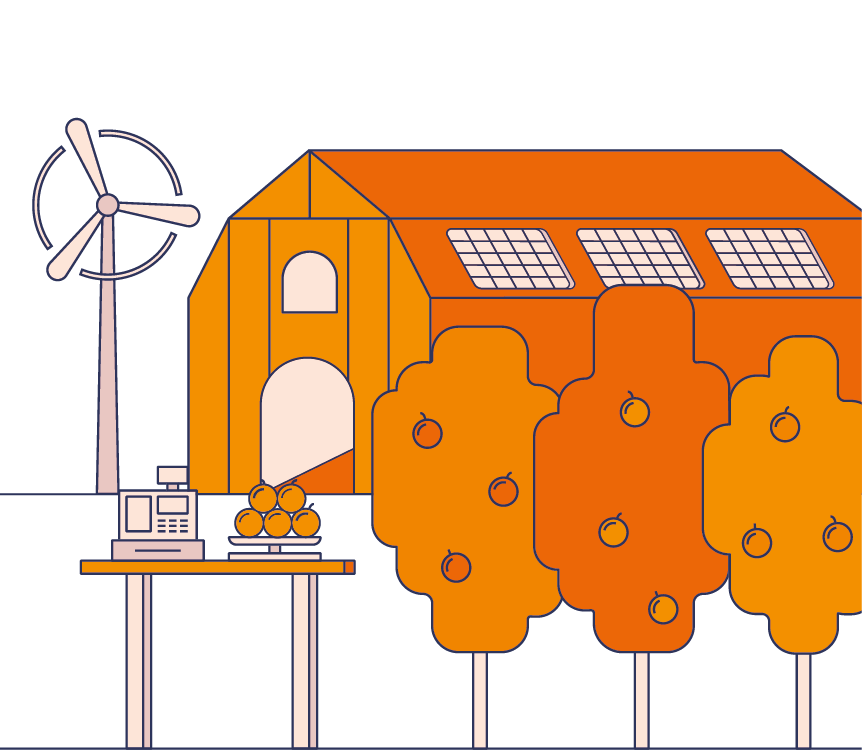
HOW WILL OUR FOOD BE PRODUCED IN 2050?
By 2050 we will be producing our food in a circular and climate-neutral way through smart use of technology. The entire food chain will be a closed cycle. Food producers will exercise their social responsibility.
Closed cycles
By 2050 we will be producing our food in a circular and climate-neutral way, respecting people, nature and agriculture. The production of food will have a positive impact on the planet, with food production, nature and biodiversity all enhancing each other. By 2050 there will be enough food for the entire world population and the agricultural sector will have adapted to a changing climate. We will ensure that greenhouse gas emissions are virtually zero. We will establish closed cycles within the food chain, using no more raw materials than necessary. Waste flows will be reused in the chain to fertilise the soil. At the same time, we will use no more land than necessary for food production.
Food production
Healthy, fertile soil is the basis for agriculture and is part of the farmer’s business model. New and different products like seaweed, nuts and pulses will also be grown. Crops will be produced primarily for human consumption and crop residues will be used as animal feed or to improve the soil. By 2050 our food will also be produced in alternative locations, such as on rooftops, vertically on walls, on the water and in vacant buildings. The agricultural sector will be technology and data-driven, with open-source and other technology making it easy for producers to monitor their water consumption, soil and crop status, and get the latest weather forecasts. Food production will be better controlled and made more efficient through precision farming.
More than just a food producer
By 2050 food producers will exercise their social responsibility. Farmers will play an important part in nature conservation and in ensuring a living countryside. In food forests, we will combine food production with nature, recreation and education. Entrepreneurs will be able to combine food production with services to society, such as social farming, agritourism and marketing in short food supply chains. Farmers will be able to create new business models, for example by becoming data producers, supplying essential raw materials for the bio-economy or fixing carbon in the soil. Startup and transition grants will give farmers the opportunity to develop their entrepreneurial or innovative ideas themselves.
WHAT WILL RETAIL AND TRADE BE LIKE IN 2050?
By 2050 our food chain will be sustainable and transparent. Trade and retail will be the direct, green link between consumers and producers and we will pay a fair price for our food.
Sustainable, transparent and fair chain
By 2050 all links in our food chain will be sustainable and transparent, and the chain from farm to fork will be as short as possible. Farmers and other agricultural workers at home and abroad will receive fair remuneration. Large companies will use their influence to make the chain fairer and more sustainable and will no longer have a monopoly over the food supply. Within the chain, businesses will no longer compete on efficiency or lowest price, but primarily on quality, nutritional value, animal welfare and the contribution made to nature or biodiversity. Short, local chains will ensure good relationships and collaboration between producers and consumers, enabling a better match between supply and demand. As a country we will focus mainly on exporting knowledge and only rarely on exporting products.
Supply
By 2050 our food supply will mainly depend on the seasons and on environmental and climate impact. Supermarkets will select products on the basis of sustainability, flavour and nutritional value, not size, shape and colour. We will determine the price of a product based on its true cost. This will encourage consumers to opt for sustainable products and will ensure that producers receive a fair price. We will use packaging only if it combats food waste by demonstrably lengthening shelf life. We will use biodegradable materials for packaging or ensure that packaging is recycled.
Logistics
In 2050 we will minimise energy consumption in the logistics chain and the energy we use will be renewable. Retail will be the direct, green link between consumers and producers. We will use technology to indicate the route a product has taken and how much energy has been used. This will provide transparency and clarity for consumers about product origin. Within the chain, we will make smart and efficient use of transport thanks to a shared general distribution network.
WHAT AND HOW WILL CONSUMERS EAT IN 2050?
By 2050 we will be aware of the impact of food choices and will have a food culture that places a premium on the quality, sustainability, nutritional value and taste of our food.
Food culture
By 2050 we will have a food culture that places a premium on the quality, sustainability, nutritional value and taste of our food. Children will learn from an early age where their food comes from and what healthy and sustainable food is. We will have an eating culture that includes experimenting with food, dining together often and spending time on cooking and eating. To reduce our impact on the planet, our proteins will mainly be plant-based protein rather than of animal origin. By 2050 eating meat will not be the norm. Our diet will consist mainly of plant-based products such as vegetables, pulses, nuts and seaweed.
Awareness and buying behaviour
By 2050 we will consciously choose sustainable, healthy products in supermarkets, which will play their part in changing consumer buying behaviour. The hotel and catering sector will introduce us to local, seasonal products. Schools and company canteens will set an example by serving healthy, sustainable meals. The government will promote a healthy, plant-based diet, for example through public information campaigns or financial incentives.
Food waste
By 2050 we will not throw any food away. We will prevent leftovers by buying in bulk less often and cooking suitable portions. Moreover, we will not be deterred if a vegetable has a blemish or a fruit is oddly shaped. Any food that is still left over will be shared, for example via an online food network. Food that is not sold on time in supermarkets will be used in the hospitality industry. If food really has reached the end of its shelf life, it will undergo circular processing; the agricultural sector will use any residual flows. It will be easy for consumers to find out about the shelf life of products, for example using a mobile app.
Education 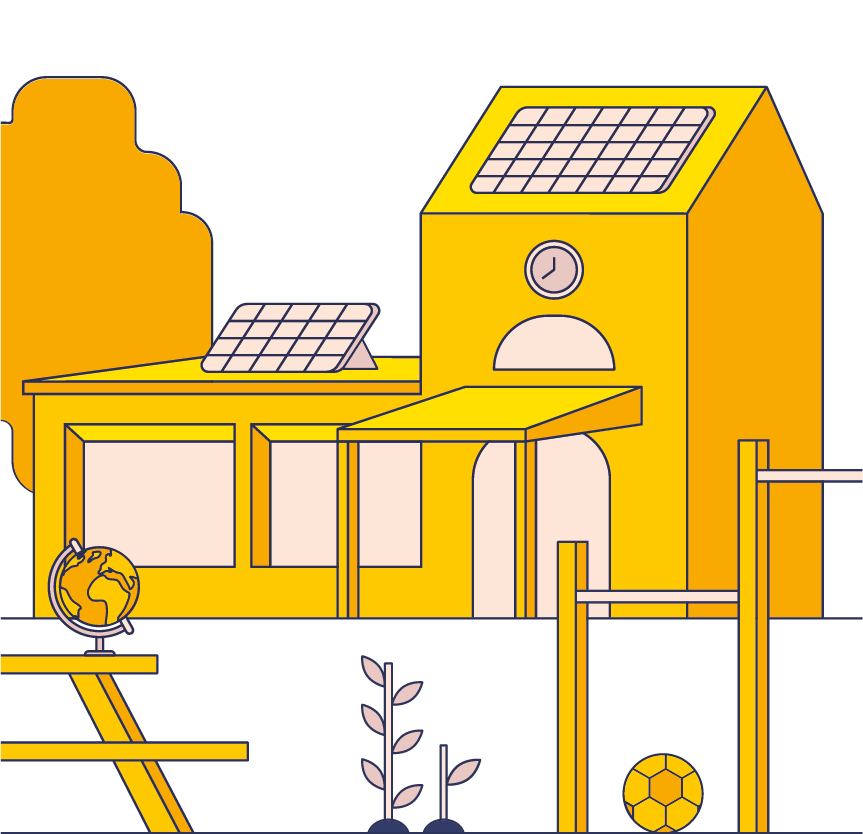
WHAT WILL THE CURRICULUM BE LIKE IN 2050?
By 2050 sustainability will be a crosscutting theme in our education system. Children will acquire the knowledge and skills needed for sustainable development from a young age, based on relevant issues and independently developed teaching material.
Sustainability as a crosscutting theme
Children will become acquainted with sustainability from an early age, with special emphasis on contact with nature. Children will learn to treat the environment with respect and their awareness will be fostered both in and outside the home. Sustainability will be a crosscutting theme throughout our education system. It will be an important part of the national attainment targets in primary and secondary education and everyone will learn about sustainability in relation to their own discipline or occupation. In addition, there will be a diverse range of post-secondary courses and particularly specialist training focusing on sustainable development.
Relevant and independent teaching material
We will learn about the natural, social and economic aspects of sustainability and how they relate to one another through discussion of relevant, current social issues. Education will prepare us for the society of the future, so the curriculum will be updated regularly to incorporate new developments. Teaching material and content will not be dependent on commercial interests and will be assessed by an independent monitoring body. This will limit the influence of big companies and help teachers select their teaching material.
Sustainable competences
In addition to knowledge about sustainability, the focus will be on various skills and outlooks, like future-oriented, solution-focused and system-based thinking, which contribute to the creation of a sustainable society. Furthermore, self-development and empowerment at all ages will play an important part in our development. We will also acquire digital skills that are crucial in a rapidly changing technological society. We will have a critical attitude towards the opportunities available, enabling us to make optimum use of technological solutions that foster sustainable development.
WHAT WILL THE LEARNING PROCESS BE LIKE IN 2050?
By 2050 teaching in traditional classroom settings will have made way for participatory learning, with a high degree of interdisciplinary collaboration. Young people in all schools will be encouraged to have a say in sustainability policy.
Interdisciplinary collaboration
In order to understand and resolve complex sustainability issues, it will often be necessary to work across disciplines. All training courses will therefore have an interdisciplinary component. One important part of the learning process will be working on cross-curricular assignments, making full use of subject-specific expertise. These projects will also involve intensive collaboration and exchange between pupils and students at different educational stages and levels. Practical and theoretical education will complement each other, with each partner in the collaboration drawing on their own abilities.
Participation
There will be a balance between teacher instruction and cooperative learning, with the teacher facilitating the learning process. Various teaching methods will be used to engage pupils and students who have different learning styles. Alongside traditional whole-class methods of instruction there will be plenty of scope for participatory learning, co-creation and enquiry-based learning, which will be made possible by creating a dynamic and flexible learning environment that encourages dialogue, experimentation and creativity.
Having a say
Educational establishments will make it easier for pupils and students to have a say in sustainability policy and will proactively seek to make implementation a joint effort. Young people will be a driving force in making their environment more sustainable. Educational facilities will encourage initiatives by young people and will provide an environment in which constant change and improvement is the norm. There will be scope within the curriculum for students to develop their own ideas about sustainability in projects. In addition, participation bodies will play an important role within educational establishments.
WHAT WILL THE LEARNING ENVIRONMENT BE LIKE IN 2050?
By 2050 all educational establishments will serve as examples for the circular society. The school will be at the heart of society, and both the building itself and the community at large will provide opportunities for learning.
The school as an example
School buildings and campuses will be energy neutral and will serve as examples for the circular society. The grounds will contain plenty of greenery and technological and ecological solutions will enable them to be used to full advantage. The focus will be on using services rather than products. School canteens will mainly use products that are plant-based, local and seasonal, with no food waste and minimum packaging. Buildings, canteens, materials and modes of transport will be used not only for their primary function but as teaching tools as well. In this way, the learning environment will help raise awareness of the impact of our consumption and we will actively address this subject.
Relationship with the community
Educational establishments will be at the heart of society. We will learn from our community through guest lectures, excursions and local, sustainable projects. Children’s learning environment will expand as they grow older, starting at local level in early years education and becoming national or even international as we pursue further education. Schools will show their community what they are doing in terms of sustainability and good examples will be recognised and shared.
HOW WILL WE ORGANISE RETRAINING AND FURTHER TRAINING IN 2050?
By 2050 retraining and further training in sustainable development will be accessible to everyone, different generations will learn from each other as a result of active collaboration and there will be a strong focus on training sustainability teachers.
Retraining
Knowledge institutions, businesses and government will work together to provide attractive retraining programmes for work in sustainable sectors. Employees will be actively encouraged to retrain for occupations that help to build a sustainable society. They will keep their salary and social safety net, making these retraining programmes accessible and affordable for all. Both theoretical and practical retraining will take place within the working environment.
Further training
Further training will be a standard part of everyone’s job and will be encouraged throughout a person’s career by employers in all sectors. This will ensure long-term employability, with everyone continuing to learn and change in order to keep up with the latest developments in their specialist area. Active collaboration between different generations will be a key focus so as to ensure a balanced exchange of experience, knowledge and expertise.
Sustainability teachers
Sustainability will be addressed in periodic in-service training for teachers. This means that all teachers will have subject-specific and interdisciplinary knowledge about sustainability and the ability to teach sustainable competences. Sustainability will have a place in all teacher training and recognition will be given to teachers who actively seek to make the education system more sustainable.
Work 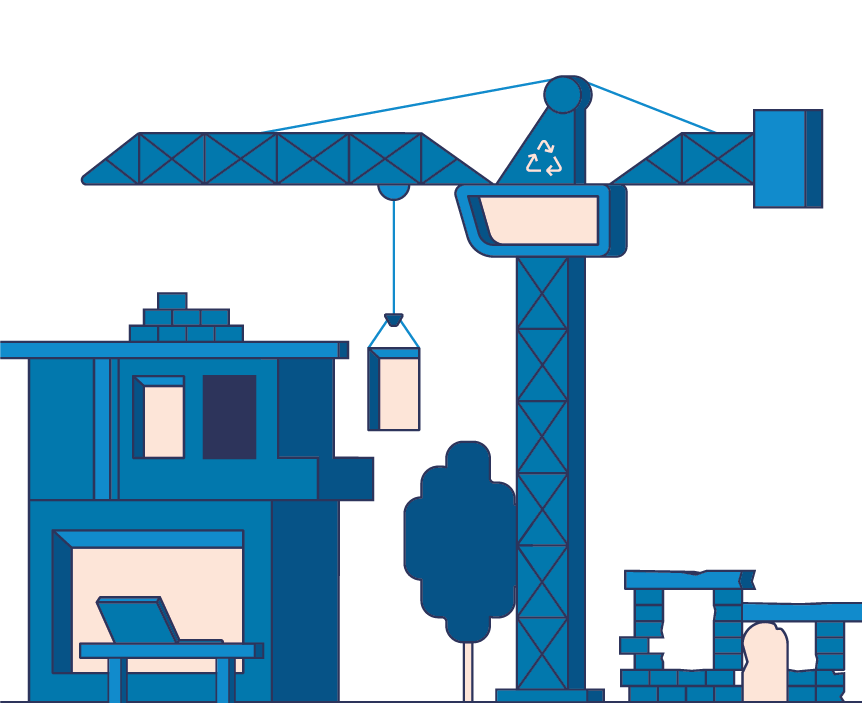
WHAT WILL OUR ECONOMY BE LIKE IN 2050?
In 2050 we will strive to achieve long-term wellbeing based on ecocentric grounds. Our economy will be circular and we will pay the true cost of our impact on the environment and on people.
Long-term wellbeing
By 2050 ecocentric thinking, seeing ourselves as part of nature, will inform our actions and behaviour. Our aim will be harmony between people, planet and prosperity. Our mindset is in line with the principle ‘enough is plenty’ and the consumer society will be a thing of the past. The government will monitor wellbeing using a wide-ranging set of indicators. We will look further than just economic growth and gross domestic product (GDP). We will also consider long-term social and ecological impact, both within and outside the Netherlands. Costs that we incur to prevent harm to the environment and to people will be weighed up against the potential cost of remedying this harm.
Circular economy
By 2050 our economy will be circular. Production will be based on circulating raw materials, powered by renewable energy sources. The basic premise will be that products should retain their value as much and for as long as possible. Circularity will be the guiding principle in product design, manufacturing processes and revenue models. All links in our production chains will work closely together to ensure closed cycles.
In most cases we will pay to use products that we share with others rather than buying to own. This means that manufacturers will continue to own their products, and will therefore have a commercial interest in ensuring that they last a long time, are repaired and are energy-efficient. By using products and materials over and over again, we will prevent overproduction and make optimum use of raw materials and energy. Manufacturers will determine where and on what scale each product can be made most sustainably. We will use renewable raw materials wherever possible. Non-renewable raw materials will be reserved for recyclable materials, and non-recyclables will have been phased out. We will minimise packaging materials and other, single-use products and any we still need will be either biodegradable or recycled, because there will be no such thing as waste.
Taxation
By 2050 the government will levy high taxes on greenhouse gases, raw materials and pollution, which will deter companies and individuals from polluting. By simultaneously keeping tax on labour low, maintaining and repairing products and materials will be more attractive and, in most cases, cheaper than throwing away and replacing them. Harmonising these taxes internationally will prevent companies moving their polluting operations abroad. Taxing pollution means that we will pay the true cost of products and services, which will encourage us to develop and consume more sustainable options, as these will be more competitively priced.
HOW WILL ORGANISATIONS WORK IN 2050?
By 2050 we will conduct business and investment activities in a sustainable and transparent manner. Stakeholders will be involved and will encourage sustainable development.
Policies of organisations
By 2050 organisations will not just be focused on pursuing their own goals. At a minimum, they will ensure that they do not harm the environment or people and will constantly strive to increase their positive impact on society and the environment. To get stakeholders involved, organisations will communicate their sustainability goals and performance. They will set a good example with their positive impact, but will be held accountable for any negative impact they cause. They will be encouraged to continue developing sustainably: internally through responsible leadership at all levels of the organisation, and externally by government, civil society organisations and individual stakeholders.
Sustainable business practice
By 2050 ecological and social responsibility will be a natural part of everyday business practice and will be incorporated into reports and business plans. Government regulation will set the ecological and social boundaries within which companies are allowed to operate. Standards will ensure that performance on sustainability indicators is communicated in a reliable and uniform manner and we will use this information when choosing between alternatives. This will also give businesses an extra commercial incentive to become more sustainable, because their customers will use this information when comparing alternatives.
Investment and stocks
By 2050 companies will disclose their financial, social and environmental performance and their internal operations in a single integrated annual report. This transparency will help investors understand how companies have performed and enable them to invest in those with sustainable policies. Shareholders will also encourage the businesses in which they invest to make a more positive impact on the environment and on people. Banks, equity funds and insurers will publish investment agendas so that we can choose how our money is used.
HOW WILL WE BE WORKING IN 2050?
In 2050 we will all engage in sustainable development, both at work and at home. We will use the increased leisure time available in ways that are sustainable, creative, social and healthy.
Working on sustainable development
By 2050 we will deploy our skills in meaningful work that contributes to a sustainable society. We will all have the time and freedom to engage in sustainable development at work, as part of and in addition to our usual duties and responsibilities. Employers will give us the opportunity to influence their policy on sustainability, which will engender support for and commitment to sustainable development at every level and in every department of the organisation.
Labour market
In 2050 sustainable jobs, e.g. in the energy sector, will be attractive and sought-after and will be promoted through, for example, campaigns conducted by the government and sectoral organisations. Tasks that artificial intelligence and robots can perform better and more efficiently will have been automated. The resulting cost savings will benefit those who used to do this work, directly from employers and indirectly through taxation. A significant proportion of this money will be used to train or retrain people and help them find new jobs. This will help us meet demand for labour in sustainable industries. There will be no fossil-fuel or polluting industries.
Leisure
By 2050 we will not have to spend so much time working to earn enough money to get by, thanks to automation, conscious consumption and the sharing economy. We will use our leisure time in ways that are sustainable, creative, social and healthy. Recreation will be more about community than about individual consumption. Through our upbringing and education and the efforts of the leisure industry, we will be encouraged to pursue sustainable leisure activities. Only where this fails to prevent harm to people or the environment will government take deterrent measures. We will often spend time enjoying nature without causing any damage to natural areas. This will strengthen our commitment to sustainable development.
Transport 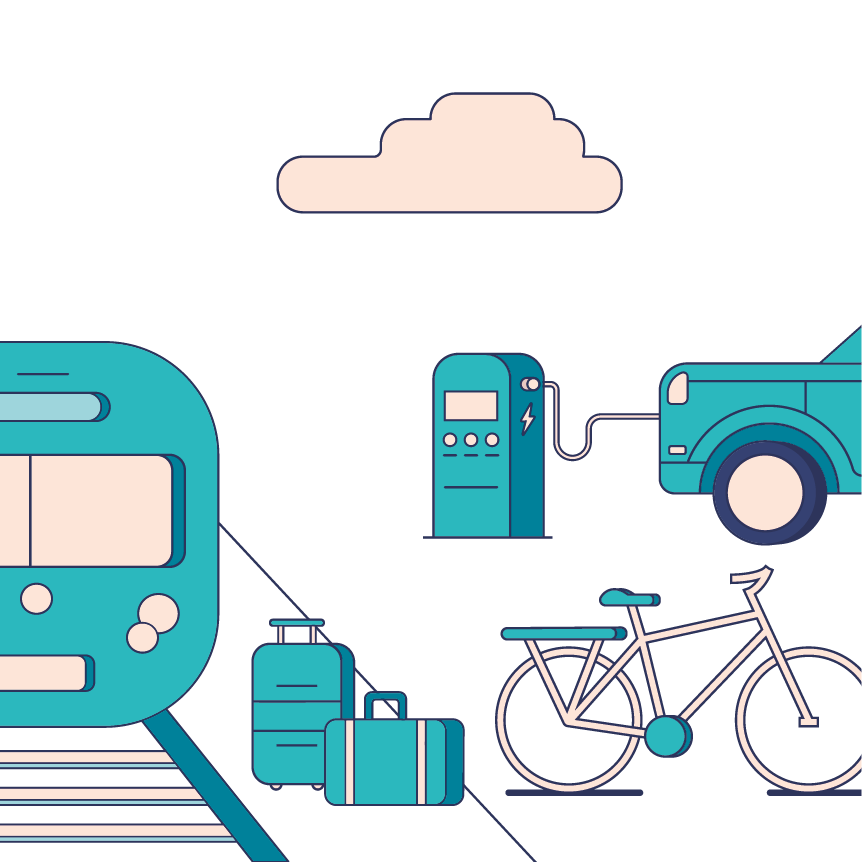
HOW WILL WE TRAVEL WITHIN THE NETHERLANDS IN 2050?
In 2050 we will opt for the most appropriate mode of emission-free transport for each journey we take. Journey planners will help us make these choices by providing us with information about the sustainability of travel recommendations. For everyday travel and outings, we will share vehicles and use public transport.
Everyday travel
In 2050 we will consciously choose the most appropriate mode of transport for each journey we take. Journey planners will help us decide by providing information not only about travelling times, but also about the sustainability of the travel recommendations. We will use this to adapt our travel behaviour. Emission-free vehicles will have replaced fossil fuel-powered cars as the dominant form of transport for everyday travel, for instance to work, school or the shops. For short journeys we will mostly travel by bicycle or on foot. Car-free city centres will offer plenty of scope for this, and even outside built-up areas good cycle paths will make cycling an attractive option. Employers will encourage their employees to actively think about their travel behaviour, for example by offering a company public transport pass or allowances for purchasing and using a pedal-powered or electric bicycle. Moreover, working from home on a regular basis will mean that we do not need to travel as often or as far.
Longer distances
By 2050 we will use emission-free public transport for travelling longer distances, often using bicycles for the first and last mile of the journey. It will be easy to park bicycles at stations, where affordable rental/shared bikes will always be available, including electric models. Buses, trams and metros will complement a high-frequency rail network with fast, logical connections, so that the number of transfers is kept to a minimum. By using driverless buses with dynamic routes in less populated parts of the country, we will have made the transition from the car to public transport there, too.
Electric vehicles and car sharing
People who are still dependent on cars in 2050, for example because of their job, will use electric vehicles (shared or otherwise), which can be recharged quickly and easily. Integrating battery-powered cars into the smart grid will also provide extra capacity to cope with peaks and troughs in electricity supply and demand. By sharing cars and car journeys, we will waste fewer resources and less energy, money and space on manufacturing, buying and parking cars. Cars will be an unpopular choice for extensive use because owning one will be viewed as unnecessary. Driving a car will also be more expensive than the various alternatives.
Travelling in our free time
By 2050 everyone will be able to reach popular leisure destinations by public transport. All stops and vehicles will be accessible, regardless of age or physical condition, including for people with disabilities. Public transport will also run until late at night, so we will not have to worry about missing the last connection. In situations where public transport is still problematic, we will be able to use shared electric vehicles.
HOW WILL WE TRAVEL ACROSS BORDERS IN 2050?
By 2050 international travel will involve conscious choices. We will avoid unnecessary business trips by arranging virtual meetings. We will mostly remain within Europe for holidays and will travel comfortably by train.
Business trips
By 2050 our approach to domestic and international business trips will be well-considered and efficient. Good telecommunications will enable us to hold virtual meetings smoothly and effectively. On the rare occasions when we do want to meet in person, we will use a fast international rail network to travel to a centrally located point. Journey planners and ticket providers will work together across borders to facilitate this. We will only travel by air in exceptional circumstances. Trains and stations will be comfortable, making them excellent workplaces, so we will be able to use our travelling time productively. Employers will take the environmental and human impact into account when choosing a mode of transport, and will not mind employees taking extra time to travel if needed.
Holidays
In 2050 we will usually spend our holidays close to home, in the Netherlands or elsewhere in Europe. We will hardly ever travel between continents and flying will be a rare occurrence. Comfortable, affordable rail travel will ensure that European destinations are within easy reach. Once we arrive at our destination we will occasionally make use of a hired or shared electric vehicle. A high-quality European fast-charging infrastructure will allow us to travel longer distances. We will view any additional travelling time as part of our holiday. On long-distance public transport, we will be able to enjoy entertainment facilities on-board and at stations. Airline tickets will be expensive due to the abolition of tax exemptions and the fact that we will be paying the true cost. Aeronautical engineering companies and airlines will constantly innovate to ensure that the most fuel-efficient planes are in use. We will continue to carry out research into solutions for sustainable aviation and develop innovative modes of transport to sustainably cover long distances at high speed.
WHAT WILL GOODS TRANSPORT BE LIKE IN 2050?
In 2050 we will minimise energy consumption in the logistics chain, within which we will work together flexibly. We will use renewable energy for transportation, with most of the journey taking place by water and rail. City centres will be supplied by combining deliveries through hubs.
Freight
Goods transport will be sustainable by 2050. A systemic change will have taken place in the transport and logistics sector, similar to that in our own travel. We will minimise energy consumption in the chain rather than aiming for the highest speed at the lowest cost. The energy that we use will be renewable. Producers, shippers, carriers and customers will all coordinate transportation flexibly to respond to changing circumstances.
Making transport more sustainable
By 2050 we will have minimised the number of road haulage miles by making extensive use of rail and water. Lorries will only be used for the first and last part of each journey and will run on clean fuel such as hydrogen or electricity. Shipping will become more sustainable with the introduction of new vessels fuelled by renewables. Only time-critical products will still be transported by air freight, which will no longer be used for luxury products.
Supplying stores and parcel delivery
By 2050 we will supply our cities via distribution hubs on the outskirts, using small, light electric vehicles and bicycle couriers to combine and deliver goods to their final destination. The orders we place will not usually be delivered to our front door. By collecting them from a pick-up point within walking distance we will minimise the last, unnecessary, time-consuming and expensive miles for delivery services. We will also be efficient in terms of product miles, because we will be conscious consumers, while manufacturers will optimise both the site and scale of their operations.
